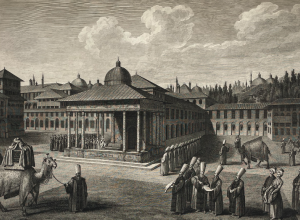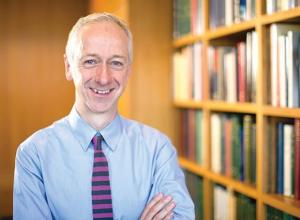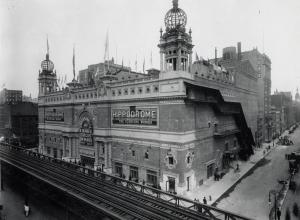Ransom Center Exhibition Explores Greenwich Village Bohemia Culture Through Bookshop Door
AUSTIN, Texas—The Harry Ransom Center's exhibition "The Greenwich Village Bookshop Door: A Portal to Bohemia, 1920-1925" showcases how one artifact, in this case a door from a Greenwich Village bookshop in the 1920s, can serve as a starting point to reconstruct the history of a time and place.
The door, which is covered in signatures of visitors to the bookshop, serves as an entryway into the lives, careers and relationships of New York City bohemians of that era. Drawn entirely from the Ransom Center's collections, the exhibition highlights items related to the bookshop, the era and the signers themselves.
The exhibition runs from Sept. 6, 2011, through Jan. 22, 2012, at the Ransom Center, a humanities research library and museum at The University of Texas at Austin. The gallery exhibition is a physical complement to a web exhibition of the same name, which launches Sept. 1 at www.hrc.utexas.edu/bookshopdoor.
As early as 1921, noteworthy visitors to Frank Shay's bookshop, located at 4 Christopher Street in the heart of the Village, began signing the narrow door that opened into the store's back room. When the shop closed in 1925, manager Juliette Koenig preserved the door. The Ransom Center purchased the door in 1960 and added it to the collection of Christopher Morley, who was a patron of the shop and a friend of many of the door's signers. The Center published a brief article about the door in 1972 in "The Library Chronicle," but the door has never been investigated thoroughly.
Many of the signatures on the door represent significant figures in the literary Modernism canon: Theodore Dreiser, John Dos Passos, Upton Sinclair, Sherwood Anderson, Sinclair Lewis and Vachel Lindsay. Many more are remembered for their roles in the Greenwich Village and wider New York intellectual scenes. Other signers include founders of the Provincetown players, the theater troupe that launched Eugene O'Neill's career, as well as Hollywood screenwriters, "bohemian" characters, book designers, cartoonists and pilgrims to the Village.
The door is signed on both sides by more than 240 artists, writers, publishers and other notable habitués of the bohemian scene in New York at the time, and the exhibition uses the signatures to reconstruct the intersecting communities that made Greenwich Village famous as an epicenter of Modernism.
Like many Village businesses, the shop was as much an intellectual and social enterprise as a commercial one. Founder Frank Shay not only ran the shop, he also published a newspaper, books and a poetry magazine from the same address. The shop stocked publications that mirrored its range of customers: socialist magazines, commercial weeklies, avant-garde poetry, best-selling novels, children’s picture books and the latest censored shocker.
The exhibition is divided into four sections: "Reconstructing the Bookshop," which uses shop stationery, publications, maps, reconstructions of shop window displays and more to immerse visitors in New York bohemia from the era; "Deciphering the Door," which includes the door itself; "Christopher Morley," which looks at the man who was at the center of the community; and "Autograph Communities," which highlights some of the most interesting names and communities represented on the door.
The exhibition also includes a touch screen where visitors can delve more deeply into the connections between the door signers through the web exhibition.
"A Portal to Bohemia" introduces visitors to the relationship between artistic and commercial production during the modernist period and offers a window to a world in which the two were very much combined. A haven of experiment and unconventional living, the Village was also a place where the modern book and magazine businesses and professional modern theater flourished, laying the foundation for the creative culture of New York as we know it today.
"As we all know, bookselling and buying have changed dramatically in recent years," said Ransom Center Cline Curator of Literature Molly Schwartzburg. "Not long ago, bookshops were important to the social and intellectual community of any given city or town, and as that changes it is important to understand the history of bookshops, both as businesses and as gathering places."
High-resolution press images from the exhibition are available.
"A Portal to Bohemia" can be seen in the Ransom Center Galleries on Tuesdays through Fridays from 10 a.m. to 5 p.m., with extended Thursday hours to 7 p.m. On Saturdays and Sundays the galleries are open from noon to 5 p.m. The galleries are closed on Mondays.
The door, which is covered in signatures of visitors to the bookshop, serves as an entryway into the lives, careers and relationships of New York City bohemians of that era. Drawn entirely from the Ransom Center's collections, the exhibition highlights items related to the bookshop, the era and the signers themselves.
The exhibition runs from Sept. 6, 2011, through Jan. 22, 2012, at the Ransom Center, a humanities research library and museum at The University of Texas at Austin. The gallery exhibition is a physical complement to a web exhibition of the same name, which launches Sept. 1 at www.hrc.utexas.edu/bookshopdoor.
As early as 1921, noteworthy visitors to Frank Shay's bookshop, located at 4 Christopher Street in the heart of the Village, began signing the narrow door that opened into the store's back room. When the shop closed in 1925, manager Juliette Koenig preserved the door. The Ransom Center purchased the door in 1960 and added it to the collection of Christopher Morley, who was a patron of the shop and a friend of many of the door's signers. The Center published a brief article about the door in 1972 in "The Library Chronicle," but the door has never been investigated thoroughly.
Many of the signatures on the door represent significant figures in the literary Modernism canon: Theodore Dreiser, John Dos Passos, Upton Sinclair, Sherwood Anderson, Sinclair Lewis and Vachel Lindsay. Many more are remembered for their roles in the Greenwich Village and wider New York intellectual scenes. Other signers include founders of the Provincetown players, the theater troupe that launched Eugene O'Neill's career, as well as Hollywood screenwriters, "bohemian" characters, book designers, cartoonists and pilgrims to the Village.
The door is signed on both sides by more than 240 artists, writers, publishers and other notable habitués of the bohemian scene in New York at the time, and the exhibition uses the signatures to reconstruct the intersecting communities that made Greenwich Village famous as an epicenter of Modernism.
Like many Village businesses, the shop was as much an intellectual and social enterprise as a commercial one. Founder Frank Shay not only ran the shop, he also published a newspaper, books and a poetry magazine from the same address. The shop stocked publications that mirrored its range of customers: socialist magazines, commercial weeklies, avant-garde poetry, best-selling novels, children’s picture books and the latest censored shocker.
The exhibition is divided into four sections: "Reconstructing the Bookshop," which uses shop stationery, publications, maps, reconstructions of shop window displays and more to immerse visitors in New York bohemia from the era; "Deciphering the Door," which includes the door itself; "Christopher Morley," which looks at the man who was at the center of the community; and "Autograph Communities," which highlights some of the most interesting names and communities represented on the door.
The exhibition also includes a touch screen where visitors can delve more deeply into the connections between the door signers through the web exhibition.
"A Portal to Bohemia" introduces visitors to the relationship between artistic and commercial production during the modernist period and offers a window to a world in which the two were very much combined. A haven of experiment and unconventional living, the Village was also a place where the modern book and magazine businesses and professional modern theater flourished, laying the foundation for the creative culture of New York as we know it today.
"As we all know, bookselling and buying have changed dramatically in recent years," said Ransom Center Cline Curator of Literature Molly Schwartzburg. "Not long ago, bookshops were important to the social and intellectual community of any given city or town, and as that changes it is important to understand the history of bookshops, both as businesses and as gathering places."
High-resolution press images from the exhibition are available.
"A Portal to Bohemia" can be seen in the Ransom Center Galleries on Tuesdays through Fridays from 10 a.m. to 5 p.m., with extended Thursday hours to 7 p.m. On Saturdays and Sundays the galleries are open from noon to 5 p.m. The galleries are closed on Mondays.















